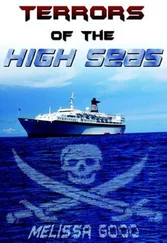On the other hand, the Commander-in-Chief had immediately taken the offensive himself, although all he could promise himself for a result was the intimidation of the Russian naval forces in the Baltic. In spite of the fact that at the outset he had only two light cruisers, Augsburg and Magdeburg, a few torpedo-boats and some steamers, converted into mine-layers, at his disposal, he did not wait for the Russians to attack, but, immediately after the declaration of war, put to sea and bombarded Libau. The bombardment did not do much damage, it is true, but it compelled the Russians to take a hand in the work of demolition. Moreover, mines were laid at the entrance of the Gulf of Finland.
Our purpose was completely attained and compensated for the loss of the light cruiser Magdeburg, which ran ashore in a haze on August 27 and had to be abandoned. On October n the armoured cruiser Pallada, which had distinguished itself by shooting at the Magdeburg when she was stuck fast, fell a victim to our "U 26" (Freherr von Berckheim). This success did not fail to have a paralysing effect on Russian enterprise.
Without going further into the details of the operations in the Baltic their effect on the general situation at home can be described as extremely important. Without depriving the Fleet of important forces and thereby weakening or quite paralysing it, the modest forces employed kept the Russians in check, so that there was no bombardment of the German coast from the sea, and traffic in the Baltic, which was absolutely vital for war purposes, was not interfered with. The observation and security of the southern exit of the Belt and Sound made it possible for us to use the western basin of the Baltic for the Fleet's battle practices. Without such a training area the exercising, of the new units which had been formed at the beginning of the war would have been very difficult. In the same way it would have been very doubtful whether we could have carried out trial trips and the first gunnery tests of newly commissioned ships.
As the war proceeded the importance of the western Baltic as an aid to keeping the Fleet ready to strike became a matter of life and death. Without constant training of an appropriate kind the standard of gunnery and navigation would have sunk to a precarious level. When navigating on a raid in the North Sea the attention of the Flag Officers was fully taken up with the possibility of enemy counter-measures and more especially with defence against underwater attack. Half the ship's company were on watch at action stations and the engine-room complement were on watch down below, and as their duties required their whole attention it was no good thinking of carrying out useful exercises of the whole ship's company under the direction of the commander. We could only expect victory in battle if we succeeded in maintaining that standard of training in which we saw our sole and overwhelming chance of beating the enemy. A suitable practice area for this purpose was the Baltic, with Kiel Haven as base. Without this area at our disposal the development which our submarine weapon subsequently underwent would have been quite unthinkable.
In view of the importance of this practice area for our operations and the valuable establishments at Kiel dockyards, especially the torpedo-establishments at Friedrichsort, on the efficiency of which the whole submarine war was later to depend, it appears incredible that the enemy made no efforts to open this vital vein. At the beginning of the war the mining by the Danes of the northern and central portions of the Great Belt was in accordance with the wishes of our Naval Staff that the safety of the Baltic should) be secured. There may be some question as to whether the Danes had the right to mine these waters, for they were an international strait, but the mining, was approved by the English also, apparently because it fitted in with their plan of not penetrating into the Baltic. Our Fleet regarded these mines as a great obstacle to their freedom of movement, for they deprived it of the possibility, when large ships were sent out on a distant raid in the North Sea, of bringing them back round the Skagen into the Baltic instead of keeping them on the single line of retirement to Heligoland. For political reasons the Naval Staff regarded it as unwise to demand the opening of the Great Belt by Denmark.
Of the different mine-laying enterprises of the High Sea Fleet in the autumn months of 1914 a special mention is due to a cruise which on October 17 began at the mouth of the Ems and had the south coast of England for its goal. Four ships of the 7th Half-Flotilla (Commander Thiele) "S" 115, 116, 117, 119 were employed. These older boats had been chosen with an eye to the possibilities of casualties, because they were no longer fit for other duties. The ships' companies had all volunteered for this dangerous raid. Their task consisted of laying mines at the entrance to the Downs, the Channel leading round the S.E. corner of England from Dover to the mouth of the Thames. The English Admiralty had announced that navigation of the area between Lat. 51 15' N. and 51 41' and Long. 1° 35' E. and 3° 0' E. (that means a strip 35 nautical miles broad from the English to the Dutch coast) was dangerous on account of mines. For this reason traffic was compelled to use the open channel close to the land. It was thus under English control, and the English found their inspection service easier. By mining the channel leading into the Thames we might expect practically a stoppage of London's supplies.
England's behaviour in laying mines in the open sea, a policy made public in this announcement, released us from the necessity of observing the limits we had hitherto imposed on ourselves of restricting mine-laying solely to the enemy's coasts, an operation which was naturally attended with greater danger to the mine- layer the nearer she approached within reach of the coastal patrol forces.
The half-flotilla had left the Ems in the early hours of the morning when it was still dark. Near Haaks Lightship, 15 miles W. of the southern point of the Island of Texel, it met the English cruiser Undaunted and four destroyers of the latest type, escape from which was impossible. As this was realised our ships attacked and, after a brave defence in an action which was carried on at a range of a few hundred yards, were sunk. The English saved as many of the survivors as was possible. After we received the first wireless message that action had begun, no further news of the torpedo-boats was forthcoming, and as we had therefore to assume that they had been lost, we sent out the hospital ship Ophelia to pick up any survivors. However, the English captured her and made her prize, charging us with having sent her out for scouting purposes, although she was obviously fitted up as a hospital ship and bore all the requisite markings.
The auxiliary cruiser Berlin was sent out into the North Sea the same night. Her commission was to lay mines off the most northerly point of Scotland, as we had reason to suspect a lively movement of warships there. The cruise of the Berlin was favoured by better luck, for it was one of her mines to Which the battleship Audacious fell a victim about a week later. She was so damaged that she had to be abandoned in a sinking condition. The English succeeded in keeping secret for a considerable time the loss of this great battleship, a loss which was a substantial success for our efforts at equalisation. When the news leaked out at last its truth was definitely and decisively denied.
The following points deserve to be remembered in considering these two enterprises: (1) Mine-laying in the open seas. (2) The capture of a hospital ship which was engaged in the work of saving life from the best of motives and observing all the regulations. (3) The suppression of the news that an important ship had) been lost in the case of the Audacious.
Читать дальше












